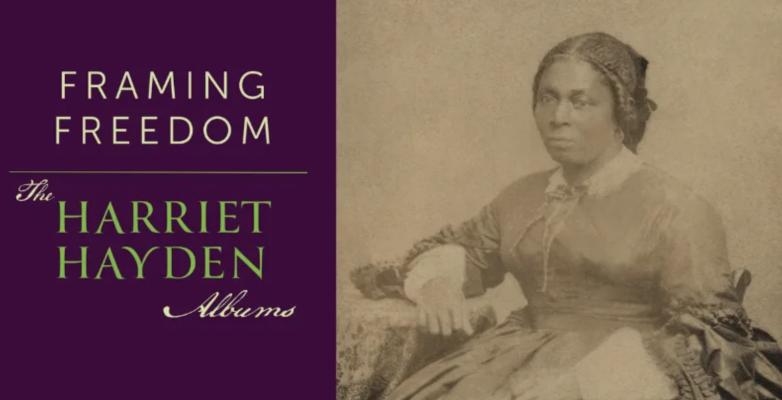First Major Exhibition of the Harriet Hayden Albums Displays Original Photos of Notable Black Bostonian and National Abolitionists

Inspired by the life and work of Beacon Hill-based abolitionist Harriet Bell Hayden, Framing Freedom: The Harriet Hayden Albums at the Boston Athenaeum brings together rarely seen works and examines Black abolitionists’ public identities, private lives, visual culture, and social activism through the perspective of a Black woman’s photograph albums from the mid-1800s.
The exhibition - which opens March 20, 2024 and runs through June 22 - centers on two photograph albums once owned by anti-slavery activist Harriet Hayden. Together, the albums contain 87 cartes-de-visite. The 2⅛ x 3½-inch portrait photographs portray many of Boston’s most prominent Black abolitionist figures including suffragist Virginia Hewlett Douglass, lawyer Robert Morris, educator Elizabeth N. “Lizzie” Smith, and Dr. John V. DeGrasse, and include rare examples by makers like the Black landscape painter Edward Mitchell Bannister.
Framing Freedom views the significance of Harriet and Lewis Hayden’s extensive social network and their influence in the social justice movements of their day. While her husband Lewis Hayden is better known for his public activism, these works encourage us to recognize the home-based activism and movement contributions of Harriet Hayden.
The exhibition features Harriet’s photograph albums alongside objects from the 19th century anti-slavery movement in Boston, including the only two known portraits of Harriet, displayed together for the first time.
This special exhibition is co-curated by Makeda Best, PhD, Deputy Director of Curatorial Affairs at the Oakland Museum of California, a specialist in 19th century photography, race, and gender, and Virginia Reynolds Badgett, PhD, former Assistant Curator at the Boston Athenaeum and scholar of American art and material culture.
“The Harriet Hayden Albums exhibition draws much-needed attention to Harriet Hayden’s role in Boston’s abolitionist movement, centering the Hayden home as a crucial site for the formation and execution of a societal crusade to which they devoted their lives,” says Makeda Best. “By integrating Harriet’s cartes-de-visite with objects from the 19th century anti-slavery movement in Boston, the exhibition offers a new contextual lens through which one can view the significance of the Haydens’ extensive social network and their historic home on Beacon Hill to understand better their influence in the social justice movements of their day."
In 1844, Harriet Hayden, her husband Lewis Hayden, and their son, Joseph, escaped slavery in Lexington, Kentucky. By 1849 they settled on the north slope of Boston’s Beacon Hill neighborhood, where Lewis opened a clothing store on Cambridge Street. It became the second largest establishment in Boston to be owned by a Black man. Their home at 66 Phillips Street served as a special place of refuge during the height of activity on the Underground Railroad, helping hundreds of self-emancipated sojourners on their journey to freedom in the wake of the Fugitive Slave Act of 1850.
In the early 1860s, Harriet received two cartes-de-visite photograph albums as gifts from fellow Boston anti-slavery activists Robert Morris and Dr. Samuel Birmingham. Harriet Hayden’s carte-de-visite albums offer a unique window into a close-knit and well-organized Black activist community and present an opportunity to re-evaluate conventional understandings of the domestic sphere and Boston’s broader abolitionist presence.
“The legacy of Harriet Hayden deserves to be better known. The albums provide insight into an under-recognized history, revealing the interconnectedness of individuals’ identities in a crucial moment in American history,” said John Buchtel, the Boston Athenaeum’s Curator of Rare Books and Head of Special Collections. “The Boston Athenaeum’s Harriet Hayden Albums exhibition tells a fuller story of our national and regional abolitionist history, and how Boston’s past and present are linked.”
Additional exhibition features connect Harriet Hayden’s carte-de-visite albums to a societal and historic narrative arc that transports the viewer from the Beacon Hill neighborhood into both the public sphere and the Hayden home. Artifacts include photographs, prints, illustrated rare books, broadsides and ephemera, American paintings, decorative arts, and personal objects associated with key individuals and the exhibition’s themes of race, gender, representation, and community.















